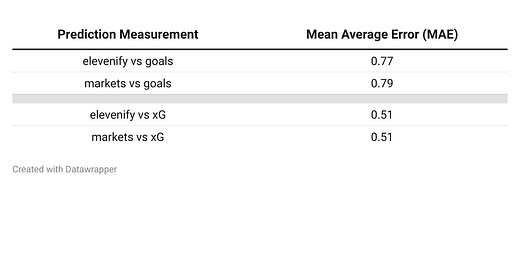Model FAQ
Questions on this page:
What is the elevenify team ratings model?
How does the model update?
What are the model inputs?
How good is the model?
Is the model based on current season only?
What can I use the model for?
What is the elevenify team ratings model?
Short version: a model that predicts football matches using estimates of team strength.
Long version: It is a statistical model that uses raw performance data (such as shots, passes, saves, possession, etc.) to generate estimates of team strength.
Team strengths have two components: an attack rating (ability to score goals) and a defence rating (ability to stop the opponent from scoring goals).
The rating numbers are ‘normalised’ and expressed as the predicted goals vs the average Premier League team. ‘Attack’ rating is the predicted goals scored, ‘Defence’ is the predicted goals conceded; and ‘Overall’ is the predicted goal difference.
These ratings are then used to create forecasts about upcoming games: goals are projected, from which we can then determine clean sheet probabilities and estimate the probability of outcomes (win, draw, or loss).
How does the model update?
Short version: strength ratings undergo adjustments following each match based on how wrong its predictions were, taking into account match performance and the strength of the opponent.
Longer version: The model uses a ‘Bayesian’ approach. This means the model starts by placing great weight on its existing assumptions (based on historical evidence from the present back to prior seasons) and updates with new evidence as the season unfolds without completely discarding its existing assumptions. This update process involves adjusting the existing assumptions based on how well the new evidence aligns with or contradicts those assumptions. Importantly, the degree of adjustment is proportional to the strength of the new evidence. Strong and consistent evidence will lead to more substantial updates, while weak or conflicting information will result in smaller adjustments.
In my opinion, this approach is a great way to calibrate beliefs appropriately based on the strength of the evidence.
What are the model inputs?
Proprietary models of this kind generally use (1) a mixture of raw performance data (e.g. shots, saves, possession, etc.); (2) more nuanced calculations (e.g. penalty likelihood, finishing skill, etc.); and (3) in the off-season blend in market spread data to capture those off-field elements that change over the summer (my model does not have any market inputs).
How good is the model?
For reference, the predictions are comparable to and can just beat out the popular but now-defunct 538 model. You may also wish to check out Simon’s model here as another comparison source. Prediction accuracy is competitive with betting market predictions, here is a live-table tracking the current season accuracy versus markets:
The model performance has been documented and tracked by Ian on his blog.
Is the model based only on the current season?
No. The update method outlined in the ‘How does the model update?’ section above doesn’t ‘reset’ when a season ends - it is continuous and carries most of its beliefs across seasons with some adjustments.
What can I use the model for?
Whatever you like really! Most people are using the model to assist with Fantasy Premier League decisions whilst some others use it to help with betting.


